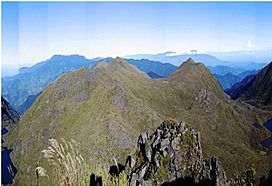Costa Rican páramo facts for kids
Quick facts for kids Costa Rican páramoTalamancan páramo Páramo Costarricense /Páramo de Talamanca |
|
|---|---|

Landscape of some of the highest peaks of the Talamanca Range with Cerro Chirripó
|
|
| Ecology | |
| Realm | Neotropical |
| Biome | montane grasslands and shrublands |
| Borders | Talamancan montane forests |
| Geography | |
| Area | 31 km2 (12 sq mi) |
| Countries | Costa Rica and Panama |
| Conservation | |
| Protected | 100% |
The Costa Rican páramo, also called the Talamanca páramo, is a special natural area. It is a type of grassland and shrubland found high up in the mountains. You can find it in Costa Rica and western Panama.
Contents
What is the Costa Rican Páramo?
The Costa Rican páramo is made up of several small areas. These areas are on the highest peaks of the Cordillera de Talamanca mountain range. This range is in eastern Costa Rica and western Panama. All together, these páramo areas cover about 31 square kilometers.
You can find the páramo above 3,000 to 3,100 meters (about 9,800 to 10,200 feet) high. It sits on top of mountains like Cerro de la Muerte, Cerro Chirripó, and Cerro Kamuk in Costa Rica. It is also on Cerro Echandi (on the border), Cerro Fábrega, and Cerro Itamut in Panama.
Lower down the mountains, the páramo is surrounded by Talamancan montane forests. Even though the páramo is small, it has unique plants. Many of these plants are similar to those found in the páramo areas of the Andes mountains further south.
Plants of the Páramo
The Costa Rican páramo has three main plant zones.
Subpáramo Zone
The lowest zone is called the subpáramo. It is a dwarf forest, meaning the trees and shrubs are very short. This area is mostly covered by a small type of bamboo called Chusquea subtessellata. You will also see other short shrubs here.
Páramo Proper Zone
Above the subpáramo is the páramo proper. This zone is full of grasses, rushes, herbs, and low shrubs. These plants belong to families like Gramineae (grasses), Asteraceae (daisies), Cyperaceae (sedges), Rosaceae (roses), and Ericaceae (heathers).
Superpáramo Zone
The highest zone is the superpáramo. This is a very narrow area. It has very few plants because it is so high up, close to where snow might be.
The páramo is home to 416 different kinds of flowering plants. About 50 of these plant species are endemic. This means they are found only in the Talamancan páramos and nowhere else in the world! The daisy family (Asteraceae) has the most species, with 73 different kinds. It even has five types of plants found only here.
Animals of the Páramo
The páramo is home to many interesting animals, even though it's a high, cool place.
Mammals
About 32 different kinds of mammals live in the páramo. These include small animals like shrews (Cryptotis) and rabbits (Sylvilagus). You can also find wild cats like the ocelot (Leopardus pardalis) and the margay (Leopardus wiedii). The powerful puma (Puma concolor) also lives here. One of the largest animals is the Baird's tapir (Tapirus bairdii), which looks a bit like a pig with a short trunk.
Birds
Around 70 different bird species have been seen in the páramo. Twelve of these birds live in the páramo all year round. Some of these special páramo birds include the red-tailed hawk (Buteo jamaicensis) and the tiny volcano hummingbird (Selasphorus flammula). Other birds, like the black-cheeked warbler (Basileuterus melanogenys) and the sooty thrush (Turdus nigrescens), also call the páramo home. Many other birds visit the páramo from the cloud forests nearby.
Reptiles and Amphibians
The páramo has one type of amphibian, which is the mushroom-tongue salamander (Bolitoglossa pesrubra). There are also two types of reptiles: the montane alligator lizard (Mesaspis monticola) and the green spiny lizard (Sceloporus malachiticus). More reptiles and amphibians live in the dwarf forests of the sub-páramo.
Insects
Scientists have found 71 different kinds of insects in the páramo. Moths and butterflies (Lepidoptera) are the most common. Some of the most often seen insects are the moth Gonodonta pyrgo, a leafhopper called Hortensia similis, and the bumblebee Bombus ephippiatus.
Protecting the Páramo
All of the Costa Rican páramo is in special protected areas. This helps keep the unique plants and animals safe.
Chirripó National Park, created in 1975, protects the largest area of páramo in Costa Rica. This includes Cerro Chirripó, which is the highest peak.
La Amistad International Park, started in 1982, protects páramo areas that stretch from Cerro Chirripó into Panama. This park is shared between Costa Rica and Panama.
Tapantí–Macizo Cerro de la Muerte National Park protects the páramo on the Buenavista mountains.
Finally, Irazú and Turrialba Volcano National Park protect páramo areas on the Irazú and Turrialba volcanoes. These volcanoes are in a different mountain range called the Cordillera Central.
Images for kids
See also
 In Spanish: Páramo de Talamanca para niños
In Spanish: Páramo de Talamanca para niños


